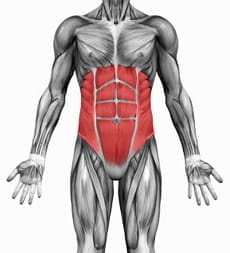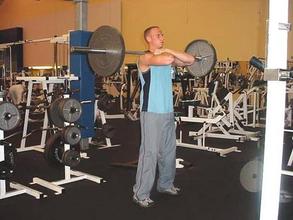This may sound a little weird to do
this in the car, but it actually WORKS to slowly help to flatten your
belly over time if done consistently
by Mike Geary, Certified Nutrition Specialist, Certified Personal Trainer
Author of best-sellers: The Fat-Burning Kitchen & The Top 101 Foods that FIGHT Aging
 With
today's short article, I wanted to show you a VERY simple exercise that
you can do anytime, anywhere to help get a flatter stomach over time.
With
today's short article, I wanted to show you a VERY simple exercise that
you can do anytime, anywhere to help get a flatter stomach over time.
Now I will preface this by saying that this specific exercise does NOT increase fat burning, but it CAN help to flatten your stomach by strengthening your deeper transversus abdominis muscles and hence "pulling in" a lazy stomach (aka beer belly or "pooch belly").
It involves doing an exercise called "ab vacuums"...
I find it a good time to get in the habit of doing daily ab vacuums while driving on your daily commute or another time that would get you in the habit of doing them regularly.
(please make sure this doesn't distract you from driving safely... I find that it doesn't distract me at all, since you can keep your eyes on the road at all times and both hands still on the wheel...it's certainly much safer than driving while on a cell phone!)
Of course, ab vacuums can be done anywhere and at anytime and don't have to be just for driving, but I've found that it helps me to remember to do them if I do them at a specific time when driving regularly.... this could be while driving home from the gym every time (I do this 3-4x per week while driving home from the gym), or perhaps during your daily commute to work.
They even help to strengthen your core and support a healthy back!
Ab vacuums are simple (Instructions)
If you actually want to BURN OFF the fat from your abdomen, you MUST apply the tested and scientifically-proven fat-burning principles on the next page.
Here's What to do Now...
On the next page below, you're going to discover some extremely SIMPLE tricks that you can apply to your daily life to BALANCE your hormones, BOOST your metabolism, and fire up your fat-burning machine inside your body... there are 101 total "tricks" you can use to flatten your stomach faster, including these:
All you have to do to discover those tricks, and so many more, is head to the Next Page...
by Mike Geary, Certified Nutrition Specialist, Certified Personal Trainer
Author of best-sellers: The Fat-Burning Kitchen & The Top 101 Foods that FIGHT Aging
 With
today's short article, I wanted to show you a VERY simple exercise that
you can do anytime, anywhere to help get a flatter stomach over time.
With
today's short article, I wanted to show you a VERY simple exercise that
you can do anytime, anywhere to help get a flatter stomach over time.Now I will preface this by saying that this specific exercise does NOT increase fat burning, but it CAN help to flatten your stomach by strengthening your deeper transversus abdominis muscles and hence "pulling in" a lazy stomach (aka beer belly or "pooch belly").
It involves doing an exercise called "ab vacuums"...
I find it a good time to get in the habit of doing daily ab vacuums while driving on your daily commute or another time that would get you in the habit of doing them regularly.
(please make sure this doesn't distract you from driving safely... I find that it doesn't distract me at all, since you can keep your eyes on the road at all times and both hands still on the wheel...it's certainly much safer than driving while on a cell phone!)
Of course, ab vacuums can be done anywhere and at anytime and don't have to be just for driving, but I've found that it helps me to remember to do them if I do them at a specific time when driving regularly.... this could be while driving home from the gym every time (I do this 3-4x per week while driving home from the gym), or perhaps during your daily commute to work.
They even help to strengthen your core and support a healthy back!
Ab vacuums are simple (Instructions)
- You can do them standing, seated (such as in a car), kneeling in a four-point position, or even lying flat on the floor. I prefer them seated or standing.
- The movement is as simple as pulling your belly button in as far as you can by imagining you're trying to touch your belly button to your spine and holding for 10-20 seconds at a time.
- Start by inhaling deeply. Then, as you exhale, start pulling the belly button in towards the spine and hold it there for 10-20 seconds while just taking short breaths. Repeat for several of these 10-20 second holds, perhaps 5-10x if you have enough time while in the car. But even just repeating 3-4x every time you're driving somewhere can really add up over time and give you the benefit of a flatter belly!
- Get in the habit of doing this at least 4-5 days per week while driving somewhere and you may find that this helps to flatten your stomach more by strengthening the transversus abdominis muscle (the deep abdominal muscles beneath the rectus abdominis) if you previously had a "lazy belly".
If you actually want to BURN OFF the fat from your abdomen, you MUST apply the tested and scientifically-proven fat-burning principles on the next page.
Here's What to do Now...
On the next page below, you're going to discover some extremely SIMPLE tricks that you can apply to your daily life to BALANCE your hormones, BOOST your metabolism, and fire up your fat-burning machine inside your body... there are 101 total "tricks" you can use to flatten your stomach faster, including these:
- Belly-Flattening Trick #1: The simple twist to your morning routine that INSTANTLY jump-starts your metabolism and boosts fat-burning by as much as 30%!
- Belly-Flattening Trick #5: The tasty beverage you've been WARNED to stay away from...but new-found studies reveal the shocking health benefits jam packed in this potent anti-aging & fat-burning "elixer"!
- Belly-Flattening Trick #15: The amazing "super-food" that in one clinical study, dissolved away more than 10 extra pounds in 12 weeks...WITHOUT DIETING or any other lifestyle changes!
- Belly-Flattening Trick #99: The candle (yes, candle) that can help maximize your body’s own natural release of age-defying, fat-melting growth hormone and have less fat on your body within the next 8 hours!
All you have to do to discover those tricks, and so many more, is head to the Next Page...













